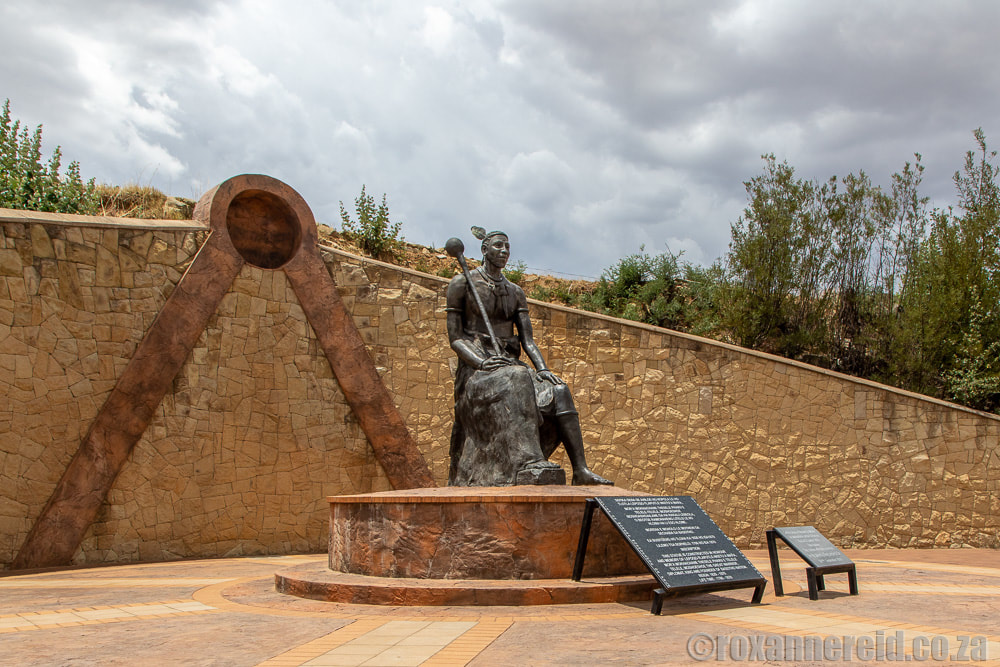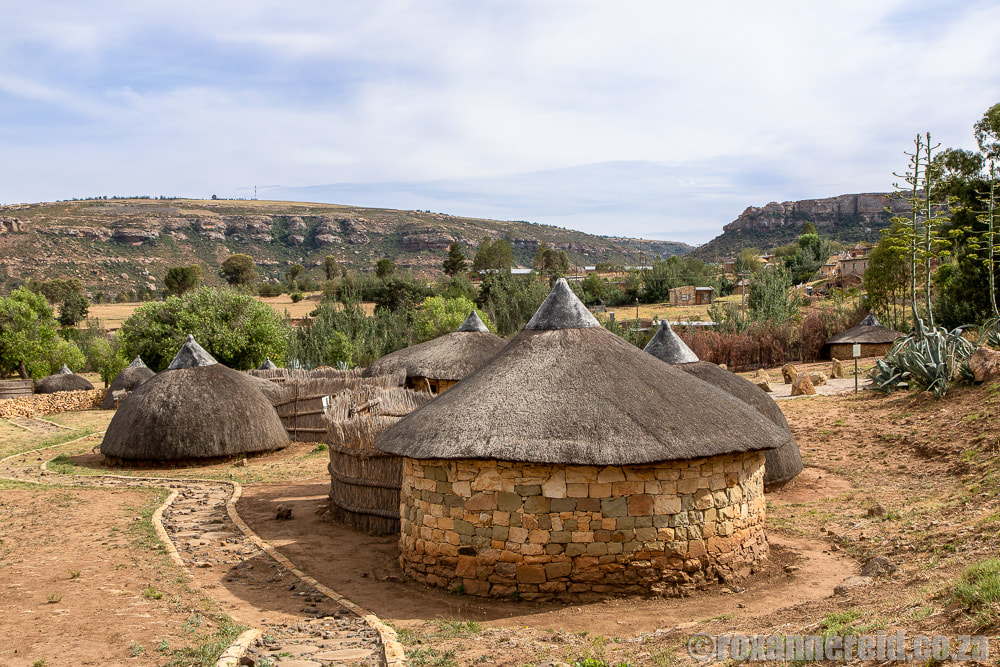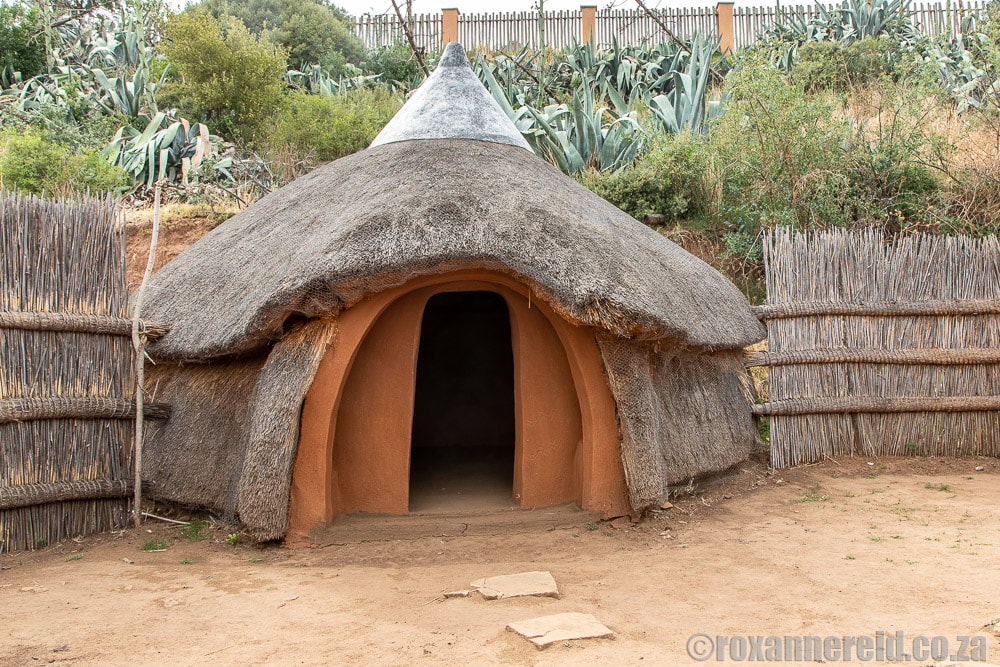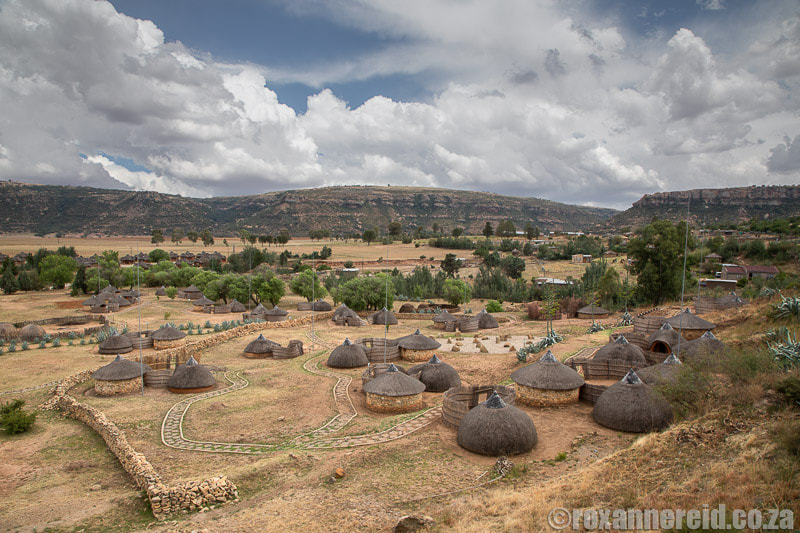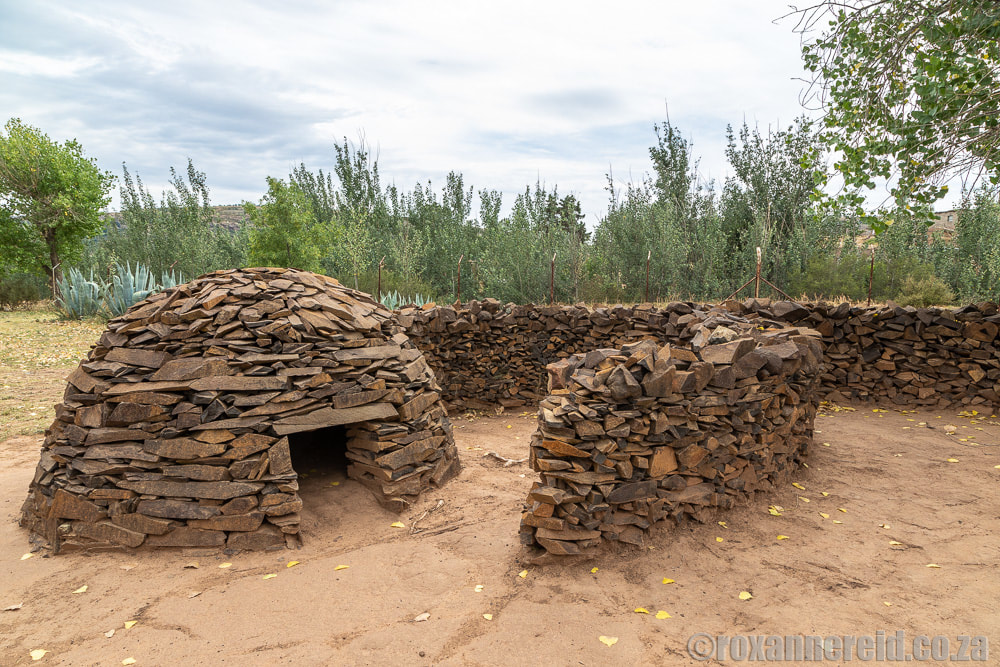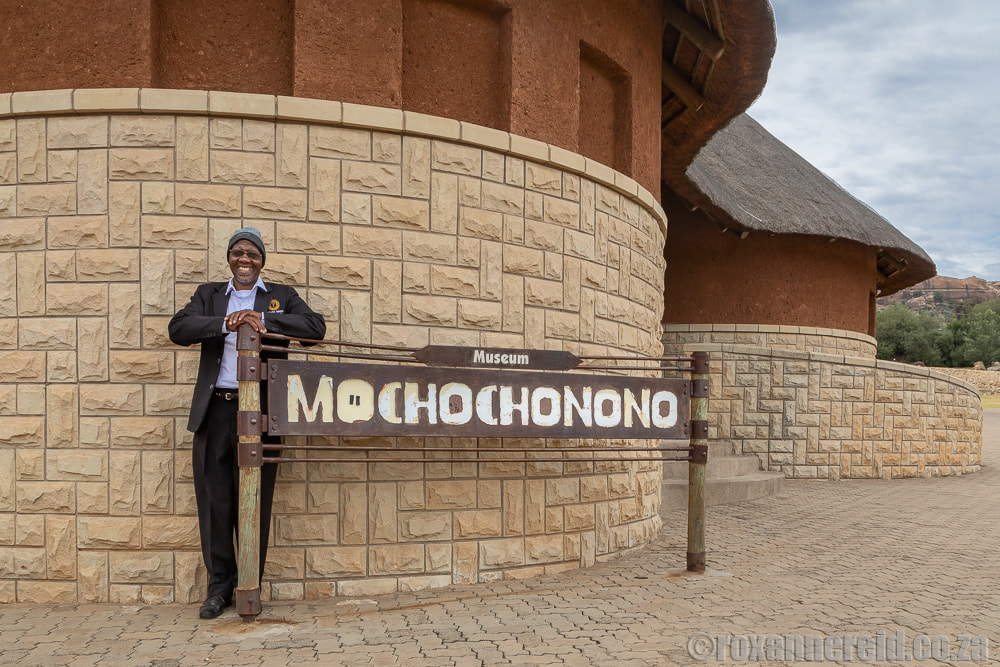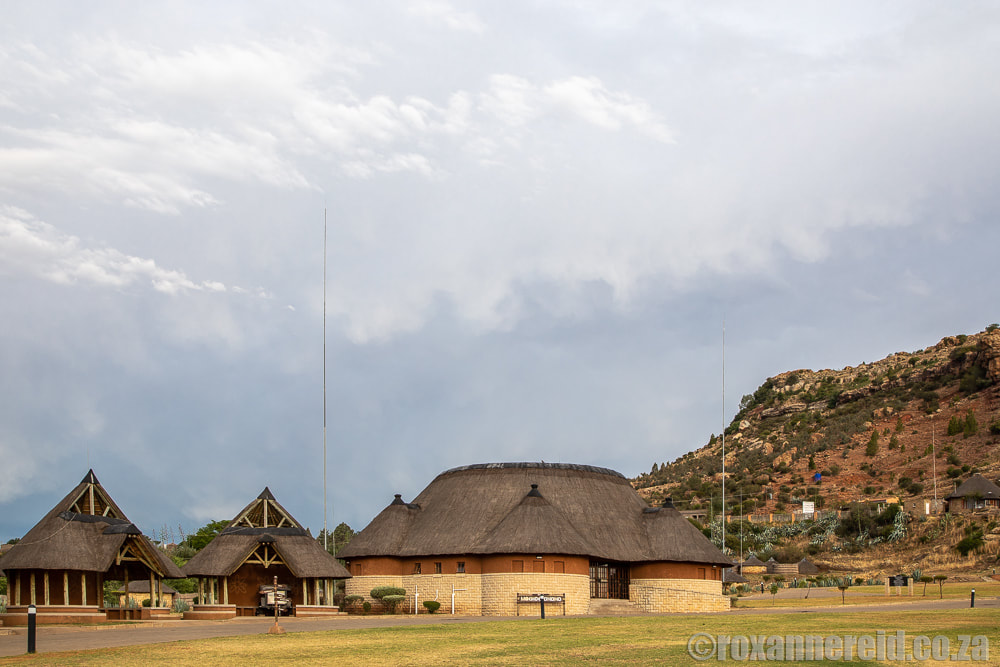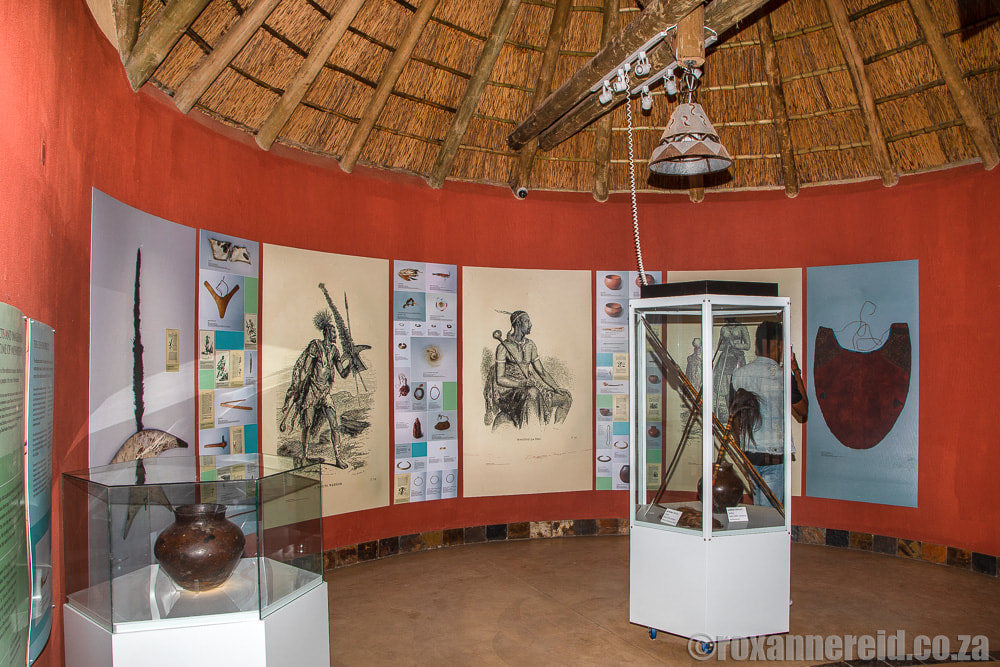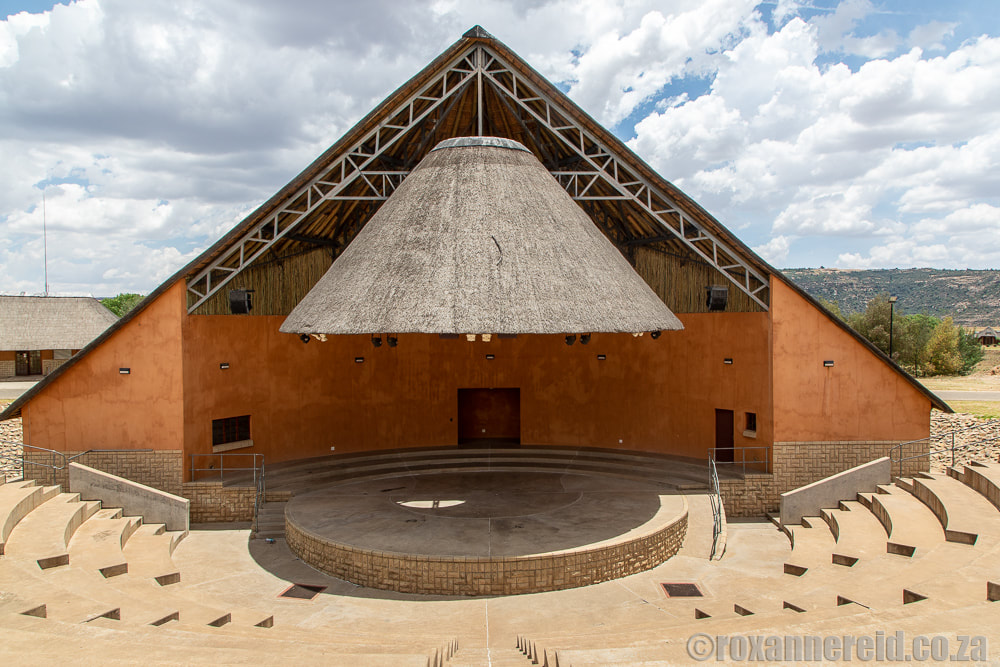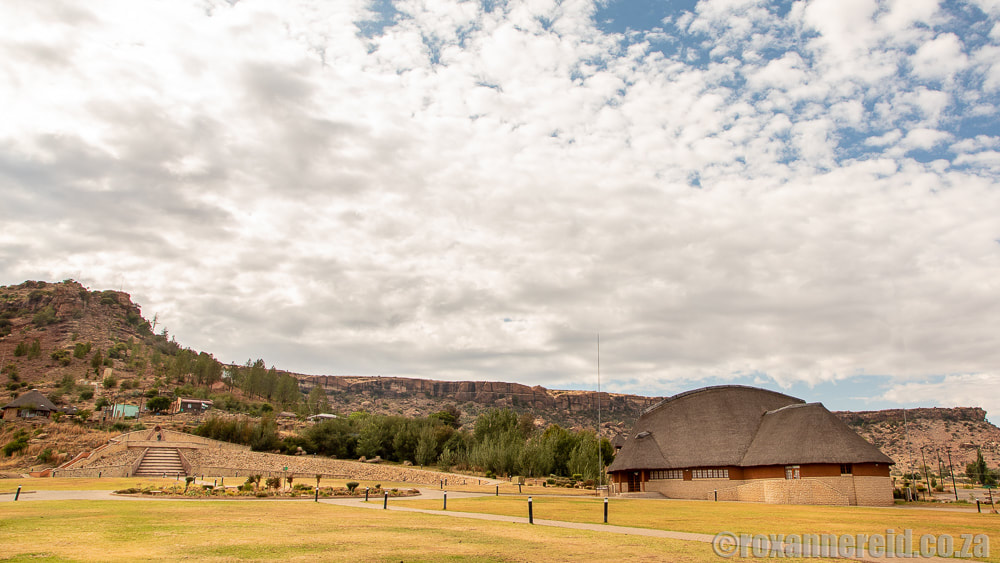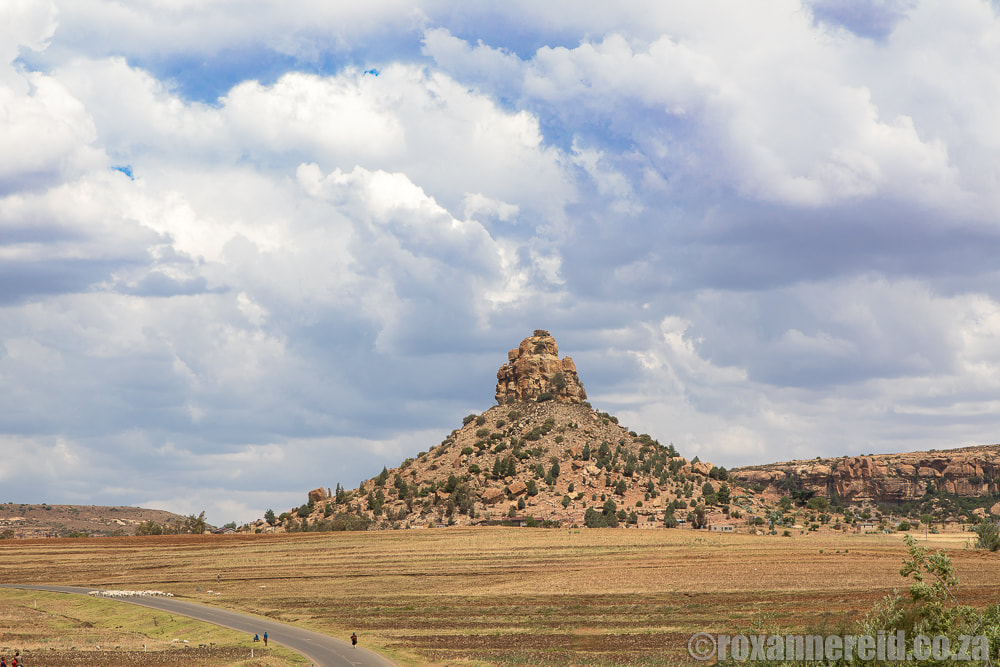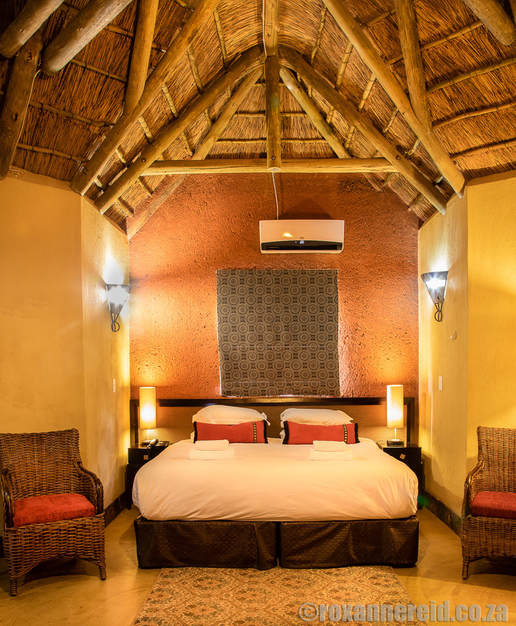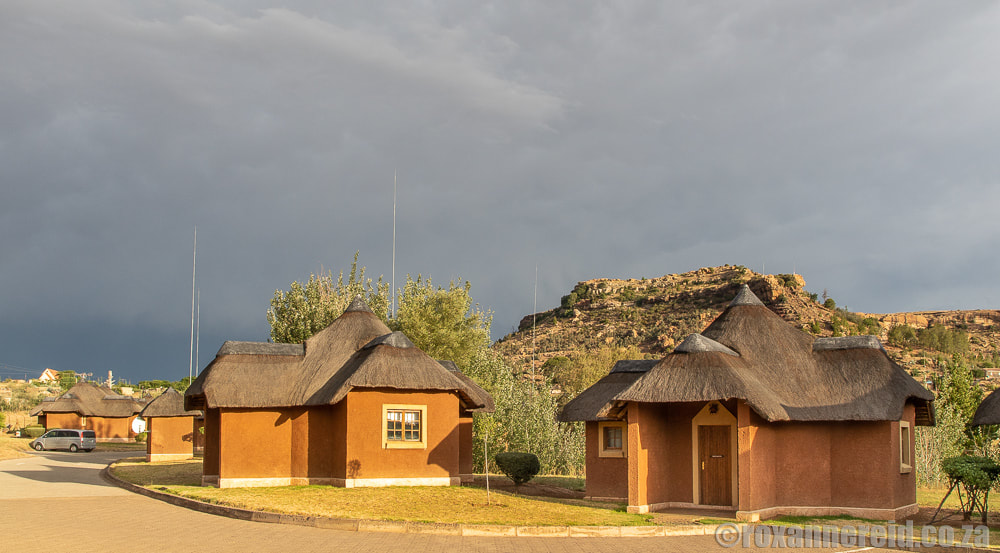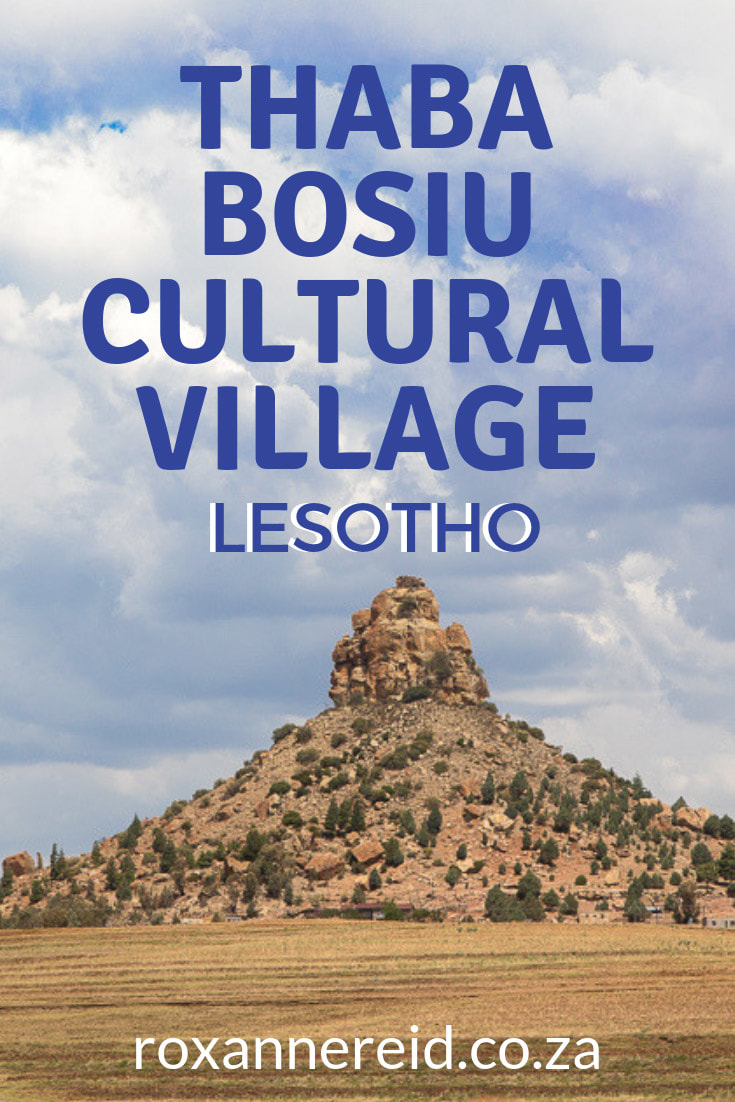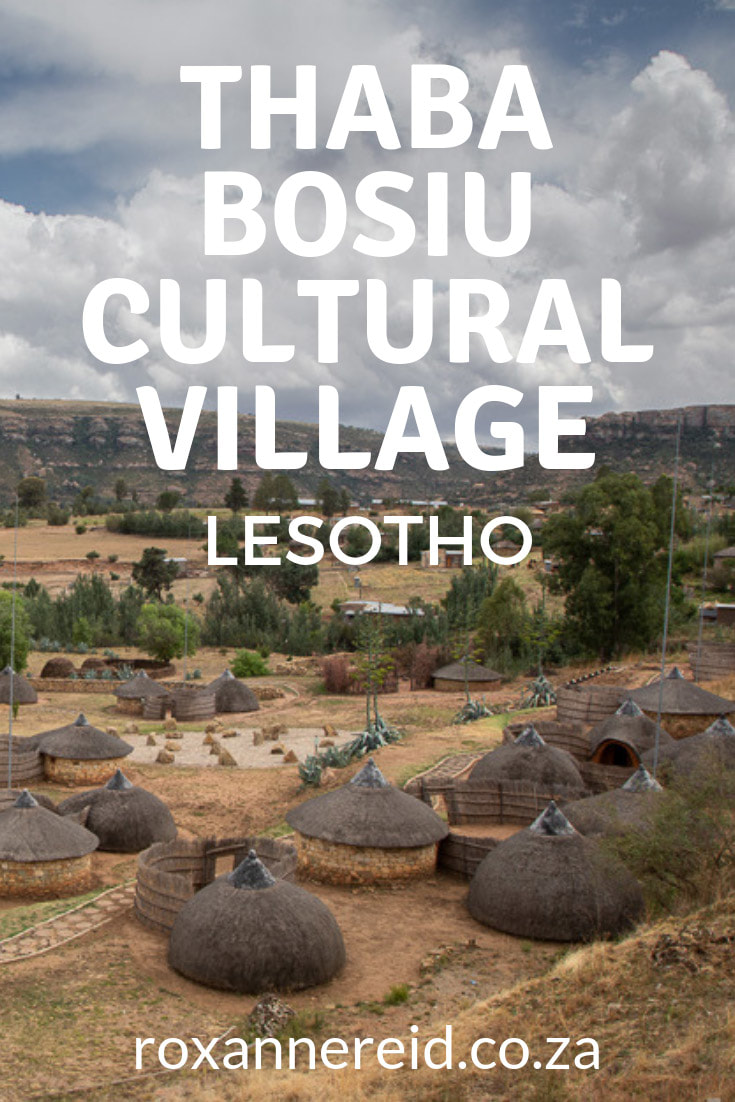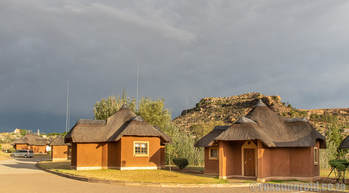
By Roxanne Reid
Thaba Bosiu, 24km from Lesotho’s capital of Maseru, is a national monument for its historical significance as the birthplace of the Basotho people. At the foot of the mountain is a place no visitor to the tiny landlocked country should miss. Find out why to visit Thaba Bosiu Cultural Village in Lesotho.
Thaba Bosiu, 24km from Lesotho’s capital of Maseru, is a national monument for its historical significance as the birthplace of the Basotho people. At the foot of the mountain is a place no visitor to the tiny landlocked country should miss. Find out why to visit Thaba Bosiu Cultural Village in Lesotho.
The Lesotho government built the Thaba Bosiu Cultural Village in 2006 but it took until 2016 for it to open. There are conference rooms, a restaurant and chalets where you can stay, but for me the wonders of the place are historical and cultural.
Monument
Centrepiece of the Thaba Bosiu Cultural Village is a monument to Moshoeshoe I, a larger-than-life statue that looks out over the whole village, its circular landscaping and paths, its museum, traditional village, amphitheatre and chalets. From the entrance, you approach the monument along a cement path inset with bare footprints so you feel as if you’re symbolically walking in Moshoeshoe’s footsteps.
Monument
Centrepiece of the Thaba Bosiu Cultural Village is a monument to Moshoeshoe I, a larger-than-life statue that looks out over the whole village, its circular landscaping and paths, its museum, traditional village, amphitheatre and chalets. From the entrance, you approach the monument along a cement path inset with bare footprints so you feel as if you’re symbolically walking in Moshoeshoe’s footsteps.
The traditional village
We walked around the traditional village in the company of guide Edgar Moiloa Rantaoleng. He pointed out two styles of Basotho huts, one where the thatch goes all the way to the ground and another with stone walls and thatch roof. The Basotho learnt the second style in 1839 from David Webber, a deserter from the 72nd Seaforth Highlanders, who sought refuge at Thaba Bosiu. ‘Moshoeshoe said you must teach us something or you can’t stay here,’ Edgar smiled.
We walked around the traditional village in the company of guide Edgar Moiloa Rantaoleng. He pointed out two styles of Basotho huts, one where the thatch goes all the way to the ground and another with stone walls and thatch roof. The Basotho learnt the second style in 1839 from David Webber, a deserter from the 72nd Seaforth Highlanders, who sought refuge at Thaba Bosiu. ‘Moshoeshoe said you must teach us something or you can’t stay here,’ Edgar smiled.
Did you know that Moshoeshoe had an incredible 140 wives? Mostly because of his habit of taking wives from all key clans to strengthen family ties. We ducked into a reconstruction of what his second wife’s home used to be like. It consisted of three huts in a walled area – one her sleeping hut, one for the children to sleep in, and one for the kitchen. Woven mats made coverings for the windows and doors, while built-in shelves made of mud like the walls were used to store her plates and bowls.
There were three schools in the village. At one the girls learned about collecting water, growing crops, grinding maize, cooking, brewing beer, weaving sleeping mats, and so on. At a second, boys learned how to go raiding for cattle and to care for them, how make animal skins soft and turn them into clothes and shoes, and how to forge iron into farming implements and weapons. The third was a school where everyone learned about the oral history of their chiefs and clans.
There was also the khotla where men spent most of their time discussing the affairs of the community, resolving disputes and imposing punishments.
Another section of the traditional village showed the different styles of homes of the 19th century, for instance Zulu huts (some Zulu people were absorbed by the Basotho when fleeing from Dingane) or the corbelled stone huts of the Bushmen. Each had an info panel about the clan’s totem. For instance, the totem of Moshoeshoe’s clan, the Bakuena, was the crocodile, while the elephant was the totem of the Batloung, the vulture of the Bakhatla and the lion of the Bataung.
Another section of the traditional village showed the different styles of homes of the 19th century, for instance Zulu huts (some Zulu people were absorbed by the Basotho when fleeing from Dingane) or the corbelled stone huts of the Bushmen. Each had an info panel about the clan’s totem. For instance, the totem of Moshoeshoe’s clan, the Bakuena, was the crocodile, while the elephant was the totem of the Batloung, the vulture of the Bakhatla and the lion of the Bataung.
Anyone staying in the chalets on site (see below) can visit the traditional village without paying.
The museum
If you’re keen on history, a visit to the museum is a must. There isn’t much in the way of artefacts, but the info panels about the history, culture and customs of the Basotho will keep you fascinated for at least an hour or two. There’s an entrance fee (R60 or 60 Maloti in November 2018) even for those staying in the chalets.
The museum
If you’re keen on history, a visit to the museum is a must. There isn’t much in the way of artefacts, but the info panels about the history, culture and customs of the Basotho will keep you fascinated for at least an hour or two. There’s an entrance fee (R60 or 60 Maloti in November 2018) even for those staying in the chalets.
Here you’ll learn about the 120km walk from Menkhoaneng in the deep of winter to Thaba Bosiu via the Place of Cannibals (Malibong), about Moshoeshoe’s grandfather Peete being taken by cannibals, and how some 4000 people finally arrived at the mountain fortress of Thaba Bosiu at night. With a flat top encircled by a sheer belt of cliffs 6-12m high, 13 springs of water, and just a handful of steep, narrow paths to the summit that could easily be guarded and defended, this was an inspired choice for a settlement during the war-like times of the Difaqane.
The word Difaqane (also known as the Lifaqane or Mfecane) means ‘time of troubles’. Between 1815 and 1840, tens of thousands of people in Southern Africa died in wars or from drought and hunger, while many were displaced from their lands. Yet from when Moshoeshoe settled his people at Thaba Bosiu in 1824 until when he died in 1870 not a single attempt to capture the mountain succeeded, including attacks by Mzilikazi, the Koranna, the Griquas and the Boers from the neighbouring Orange Free State.
The word Difaqane (also known as the Lifaqane or Mfecane) means ‘time of troubles’. Between 1815 and 1840, tens of thousands of people in Southern Africa died in wars or from drought and hunger, while many were displaced from their lands. Yet from when Moshoeshoe settled his people at Thaba Bosiu in 1824 until when he died in 1870 not a single attempt to capture the mountain succeeded, including attacks by Mzilikazi, the Koranna, the Griquas and the Boers from the neighbouring Orange Free State.
Moshoeshoe took advantage of the scattering of people by the Difaqane to conquer chiefdoms and lineages, or subordinate and co-opt them to his rule. The secret of his ahead-of-his-time leadership was to unite people with different traditions and backgrounds to form the Basotho nation in a way that allowed for diversity, yet forged a sense of national identity.
Perhaps one of Moshoeshoe’s most intriguing practices – certainly unusual for the times – was allowing young men of poor families to be treated as junior kinsmen by wealthier families. They were given cattle so they could pay the bride-price, use the cows to plough their fields and get milk to feed their families.
Perhaps one of Moshoeshoe’s most intriguing practices – certainly unusual for the times – was allowing young men of poor families to be treated as junior kinsmen by wealthier families. They were given cattle so they could pay the bride-price, use the cows to plough their fields and get milk to feed their families.
In the museum you can read the fascinating story of Moshoeshoe’s son Mohato’s initiation into manhood. Custom demanded that the ancestors’ graves be purified, but Mohato’s great-grandfather Peete had been eaten by cannibals so there was no grave. Moshoeshoe, always one to look for a diplomatic solution, had the cannibals brought to him. He made them lie down and he smeared their stomachs with animal entrails to purify them, since these were the resting place of Peete.
He even forgave them, saying, ‘You are the graves of my ancestors, you belong among us,’ before giving them a cow and a plot of land to build a house, effectively incorporating them into the Basotho nation. What a visionary leader he was, with his strategy of nation building, of gathering rather than destroying.
Don’t miss the interesting section on Basotho blankets and their history. There’s also some info on their unique designs, like the Kharetsa named after the spiral aloe (Lesotho’s national plant) or Victoria England, designed exclusively for kings, chiefs and their wives.
He even forgave them, saying, ‘You are the graves of my ancestors, you belong among us,’ before giving them a cow and a plot of land to build a house, effectively incorporating them into the Basotho nation. What a visionary leader he was, with his strategy of nation building, of gathering rather than destroying.
Don’t miss the interesting section on Basotho blankets and their history. There’s also some info on their unique designs, like the Kharetsa named after the spiral aloe (Lesotho’s national plant) or Victoria England, designed exclusively for kings, chiefs and their wives.
Shows in the amphitheatre
After our visit to the museum we stopped at the 800-seater amphitheatre for some singing and dancing. There are shows at 11:00 and 14:00 but I suggest you confirm with reception that you’re interested so they can assemble a group to perform.
After our visit to the museum we stopped at the 800-seater amphitheatre for some singing and dancing. There are shows at 11:00 and 14:00 but I suggest you confirm with reception that you’re interested so they can assemble a group to perform.
Staff ambled in from all over the cultural village to sing for us. One woman played the drum, another blew a whistle, and fly whisks flapped in time to the music. They sang about people who wanted to come down from the mountain but Moshoeshoe warned them it wasn’t safe. Afterwards, four guys with sticks, gumboots and a whistle danced for us. It was chilled and rhythmic, nothing like the warlike dancing of the Zulus – and somehow fitting from a nation like the Basotho, founded on Moshoeshoe’s peaceful and conciliatory principles.
Thaba Bosiu and Qiloane
Towering above it all is Thaba Bosiu, the mountain where Moshoeshoe created his fortress. It’s so historically and culturally important that it’s even on UNESCO’s tentative World Heritage list. Leave the Thaba Bosiu Cultural Village and turn left towards the Visitor Centre about 50m away on the left of the tar road. Here you can arrange a guide for a two-hour hike on the mountain to enjoy the views from the top and see some royal graves. Moshoeshoe and all but one of the Basotho kings are buried here. Be respectful and don’t venture where your guide says you’re not allowed.
Towering above it all is Thaba Bosiu, the mountain where Moshoeshoe created his fortress. It’s so historically and culturally important that it’s even on UNESCO’s tentative World Heritage list. Leave the Thaba Bosiu Cultural Village and turn left towards the Visitor Centre about 50m away on the left of the tar road. Here you can arrange a guide for a two-hour hike on the mountain to enjoy the views from the top and see some royal graves. Moshoeshoe and all but one of the Basotho kings are buried here. Be respectful and don’t venture where your guide says you’re not allowed.
From the Visitor Centre you can also arrange to go horse riding, or a hike to see rock paintings.
As you come out of the Visitor Centre, turn left again instead of right back towards the Cultural Village. A little further down this road you’ll see Qiloane koppie on your right. If it looks familiar, that’s because it’s said to have been the inspiration for the conical Basotho hat. It even has the knobble on the top like the traditional hat.
As you come out of the Visitor Centre, turn left again instead of right back towards the Cultural Village. A little further down this road you’ll see Qiloane koppie on your right. If it looks familiar, that’s because it’s said to have been the inspiration for the conical Basotho hat. It even has the knobble on the top like the traditional hat.
The chalets
To make the most of your visit to the area and all it has to offer, stay over in the Thaba Bosiu Cultural Village accommodation. There are about 40 really nice chalets with thatch roofs in Basotho style. Even the light fittings have Basotho panache, being shaped like the traditional conical hat.
Our open-plan chalet had a bed, a small table and chairs, TV, two armchairs and a kitchen with sink, fridge and stove. Note, though, that the rules say no preparing of food in the rooms, so it’s not self-catering and doesn’t come equipped for it. There is a restaurant on the property; you get a voucher for breakfast but have to pay extra for any lunches or dinners.
To make the most of your visit to the area and all it has to offer, stay over in the Thaba Bosiu Cultural Village accommodation. There are about 40 really nice chalets with thatch roofs in Basotho style. Even the light fittings have Basotho panache, being shaped like the traditional conical hat.
Our open-plan chalet had a bed, a small table and chairs, TV, two armchairs and a kitchen with sink, fridge and stove. Note, though, that the rules say no preparing of food in the rooms, so it’s not self-catering and doesn’t come equipped for it. There is a restaurant on the property; you get a voucher for breakfast but have to pay extra for any lunches or dinners.
I loved our chalet and enjoyed watching the wind come up and the sky blacken as thunder rolled out in the late afternoon, but was sad to see that the strings of the window blinds had already been broken and there was sun-faded tape flapping on the outside of the windows, probably from when they were varnished. These are small things that could easily be fixed.
Those niggles aside, the chalets make a comfy stay while you explore the most important historical and cultural site in the whole of Lesotho. You can even make day trips from here to places like Maseru, the God Help Me Pass (Molimo-Nthuse) to Mohale Dam, and the Kome caves.
Like it? Pin this image!
Like it? Pin this image!
You may also enjoy
Caves, cannibals and kids in Lesotho
3 Lesotho passes you have to drive, including Sani Pass
Copyright © Roxanne Reid - No words or photographs on this site may be used without permission from roxannereid.co.za
Caves, cannibals and kids in Lesotho
3 Lesotho passes you have to drive, including Sani Pass
Copyright © Roxanne Reid - No words or photographs on this site may be used without permission from roxannereid.co.za
